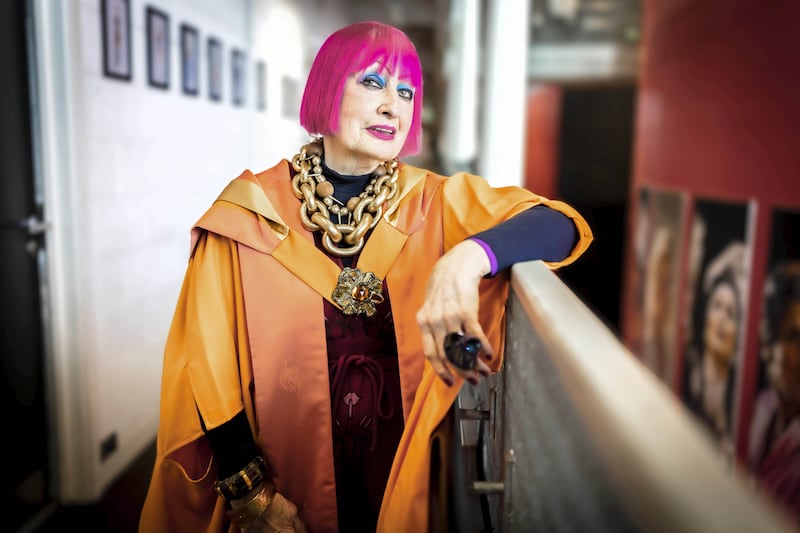In the back of a car driving along Chang’an Avenue, the grandest of Beijing’s grand boulevards, Zandra Rhodes was talking about the importance of museums. But as we passed a cluster of skyscrapers including Rem Koolhaas’s CCTV headquarters, a continuous loop known locally as “big pants”, she stopped.
“These buildings are amazing. Sorry to be led so much astray here but it’s magical. This is magical, the whole thing,” she said.
Rhodes was visiting for Beijing Design Week, where she was donating some of her most celebrated garments to a new China Design Museum which is planned for the city. The 25 garments will be shown in Beijing next year in an exhibition called Zandra Rhodes: Shocking Pink and Scarlet Dreams.
On Thursday, she handed over three of them, including a 1970 flowing jacket and skirt screen printed with her classic chevron shawl print in orange and white on candy pink chiffon with white feathers along the hem. Although she was called the “princess of punk”, Rhodes has operated in the world of high fashion for more than 50 years, making clothes for celebrities including Princess Diana, Freddy Mercury and Divine.
[ Naomi O’Leary: Ireland’s risky exposure to China comes home to roostOpens in new window ]
[ How geopolitics threatens Apple’s dependence on ChinaOpens in new window ]
At 83, her hair is still bright pink and in Beijing she was wearing a Valentino print suit accessorised with a chunky pink necklace and her own-brand sunglasses. When she is at home, she works all day every day in her studio in London, never breaking for lunch, and when she is away she sketches.
“I travel on the rule that I do a drawing a day. I like to look at what I’m seeing. You see different things and you get influenced by different things,” she said.
“Basically, I’m a print designer who couldn’t sell my prints because they were considered avant-garde in those days. So I had to found my own little print company to print the designs. And then I thought about dresses in a different way, and I made dresses, and that’s what earned me my living.”

Rhodes first visited China in 1979, crossing into Canton from Hong Kong and visiting Shanghai, Xi’an and Beijing, where she first saw the Peking Opera. She returned the following year, photographing and sketching as she travelled around the country.
“Every single person as far as the eye could see would have been in navy blue pyjama suits or they would have been in army uniforms. No make-up at all and the only jewellery would be a wedding ring and a tiny, tiny wristwatch. The only bright, colourful things were the little children, who were in all different colours,” she said.
China is now the world’s second-biggest market for luxury goods, with Chanel, Dior and Gucci the most popular high-end brands. But while European and American brands dominate in both high fashion and athletic wear, a forum at Beijing Design Week heard that trends are changing.
[ China looks to Ireland for baby-making tipsOpens in new window ]
“For young people today, those born after 1995, they prefer domestic or home-grown brands and there is a new trend emerging around de-branding. So they are not interested in the product’s brand but they are looking at the cut of the fabric, its design. So this represents a new change in the mindset of the young,” said Gu Wei from Alibaba’s digital business group AIGC.
China’s embrace of ecommerce and digital marketing has expanded the opportunities for smaller designers to sell their products, and artificial intelligence could reduce the barriers to entering the international market even further. Gu showed how AI could not only modify images to generate fashion models with different ethnic characteristics for each market but could create versions of the same video in various languages or accents and with models who look, dress and sound different in each.
“We respect the copyright of the images and we pay the models for this copyright. But we use AI technology to put the clothes on these images and to integrate other factors into them,” he said.
“I’ve forgotten which one is a real person. There’s Portuguese and Spanish as well as American, Korean and French with a lot of local models and whichever style you prefer and we find the best for the local customers. AI also helps to make video sharing to the customers more effective, especially through channels like TikTok and Facebook.”





